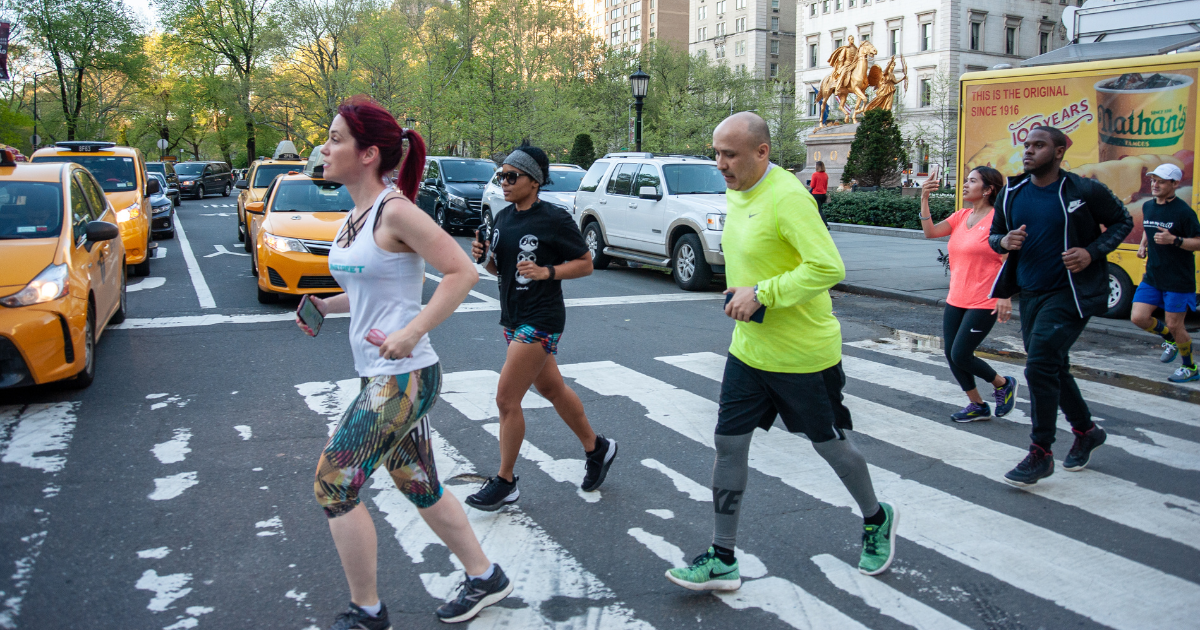How to Start Running - Tips from a Run Coach to Get You Moving
Photos by Marques Jackson Photography.
By Marnie Kunz
NASM-certified trainer, USATF- RRCA-certified run coach
If you’re wondering how to start running, this guide includes all the basics you need to know to begin a running program. One of my favorite things about coaching is helping new runners. I remember what it was like when I started running and have many tips to share to avoid a lot of problems I ran into (no pun intended:) over the years. I remember my first cross-country race felt terrible and I wondered why anyone would torture themselves like that. And here I am years later, a running coach and personal trainer, and running has become one of my favorite ways to de-stress and connect with other people and the world around me. Running is an excellent way to improve your physical and mental health, and it is much easier to do – and less expensive– than many sports. This article provides a step-by-step guide, packed with actionable tips from me, a seasoned run coach, to help you confidently begin - and enjoy - your running journey.
Related: 10 Tips for Beginning Runners
Health Benefits of Running
Running offers many health benefits and running regularly will improve your overall physical and mental health. Here are a few of the benefits you can enjoy from following a running program:
Improved mood and mental health, including reduced anxiety and depression
Better heart health and a reduced risk of high blood pressure, heart disease, and diabetes
Stronger muscles and bones and reduced risk of osteoporosis
Stress reduction. Running releases endorphins, which have mood-boosting and stress-reducing effects.
Better cognitive function. Running can also improve your memory and focus, according to researchers.
How to Start Running - Setting Realistic Expectations and Mindset
The more consistently you run, the easier it will become.
What Is a “Real Runner?”
Oftentimes new runners tell me they’re not “real” runners. Being inexperienced makes people feel like they’re not really running, or they think only fast running counts. Wipe this myth out of your mind and recognize that everyone - all paces, shapes, and ages - who runs is a runner. From the slow-jogging senior to the stroller-pushing mom running, we are all runners. Give yourself credit for what you do - if you run, you are a runner.
It’s a Marathon, Not a Sprint
Beginning runners often get overcome with excitement and want to run far right away. The truth is this can leave you injured and burned out. Practice patience and follow a gradual training program like a 5K Training Program for Beginners. Increasing your run distance slowly and incrementally will help build your endurance while reducing your risk of injuries.
Start Where You Are Now, “In” or “Out” of Shape
People often think they need to be “in shape” to start running. As long as you have your doctor’s permission to begin a running program, you can begin at any time. You don’t need to be “fit” or “in shape” to start running. Running will improve your fitness level over time, and the best time to start is now.
Try not to be hard on yourself and focus on your reason for running - whether for health reasons, a 10K race, or mental benefits. Remembering your why can help motivate you on days when your workouts feel tough (which happens to everyone - even pro athletes have off training days).
The Walk-Run Method: Easing Into Running
Your Secret Weapon: Mastering the Walk-Run
A great way to build your endurance gradually is to follow a run-walking training plan. With this type of training, you alternate between periods of walking and running, measured in minutes or distance. When you’re starting out, you may follow a program with 1 minute of running followed by 3 minutes of walking, for instance. Over time, you’ll increase your running time until you can run longer distances.
Run-walking gives you a great cardiovascular workout while building your stamina gradually. For many beginners, run-waling is less daunting than setting out to run non-stop for miles. It also minimizes your chances of injury and overtraining.
Coach’s Tip: Follow a beginner’s training schedule for a well-planned workout program to help you build up from walking to running. Our 5K Training Program for Beginners includes a run-walk program that will help you step up your fitness and build up to running a 5K (3.1 miles).
Essential Gear for Beginner Runners
Running Shoes
One of the best parts about running is that you don’t need a lot of gear. Your most essential item for running is a good pair of running shoes. Go to your local running store to get fitted for running shoes so you can find some that are comfortable and work with your training conditions. If you run mostly on trails, for instance, you will want to get trail running shoes. If you run on pavement, you’ll need running shoes with plenty of cushion.
Running Clothing
This gear checklist will help you get dressed to run.
Figuring out what to wear for new runners can be overwhelming. The good news is that you can keep it simple and just wear moisture-wicking layers. Running clothes have sweat-wicking properties that help keep your sweat away from your body so you can stay comfortable on the run. Always check the weather forecast before running outside and wear breathable fabrics that are sweat-wicking. If you dress in layers, you can always remove the outer layer if you get too warm (by tying your jacket around your waist for instance).
Budget-Friendly Tip: You don’t need expensive gear to get started running. As you get more into running, you can add accessories later - like a running watch, hydration belt, or reflective gear. For now, invest in a good pair of shoes and wear comfortable running clothes and that is all you need.
Related: What to Wear Running: Checklist from a Run Coach
Finding Your Pace and Listening to Your Body
These tips will help you run well.
You’ll often hear people say “Listen to your body” when it comes to running, but what does that mean exactly? Does that mean don’t push through pain or tough workouts? The general concept of listening to your body means to tune in to how your body feels. If you feel extra tired during a workout, make sure you’re getting enough sleep and have enough rest days in your training schedule. If you feel lingering pain on a run, take an extra rest day (or two) and see if that helps alleviate it.
The Art of Easy Effort: Finding Your Conversational Pace
For beginners, the best pace is not your fastest but a relaxed, “conversational pace.” This means when you're running, you should be able to carry on a conversation with a friend. If you are training by heart rate, your conversational pace will be in Zone 2. Most runners naturally know their base run pace (which is the conversational pace) but need to trust how they feel and go with it.
I know it’s exciting to run and you may want to go fast, but keep your pace in check now and you will reduce your risk of injuries so you can run hard in a few months, once you’ve built your fitness base.
Coach’s Tip: Pay attention to your body's signals. Pain is a sign to stop or slow down. Learn to differentiate between discomfort and injury and stop running if you are injured.
Build Consistency and Progression
From Couch to Consistent: Gradually Increasing Your Mileage
Joining a run group can help you stay accountable.
One of the most overlooked but essential parts of becoming a better runner is to run consistently. Once you have a running training plan, you can follow the program to do regular runs.
When you’re training, follow the principle of progressive overload and increase your mileage slowly. A good general rule of thumb is to increase your weekly mileage by no more than 10 percent. So if you run 10 miles in one week, for instance, you can add up to 10 percent - 1 mile - to do a total of 11 miles the next week. This gradual building of your running and walking time will improve your fitness level while minimizing your risk of getting injured. If you’re following a run-walking program, you’ll gradually increase your running intervals and decrease the amount you walk between the running segments.
Taking rest days is also an important part of training and it will help prevent you from getting mentally or physically burned out.
Coach's Tip: The more consistently you run, the easier it will become a habit that you do without thinking much about. Set small, achievable process goals - such as running 4 or 5 times a week for at least 20 minutes - and this will help you stay on track with consistent workouts.
Injury Prevention for New Runners
Running injuries are pretty common for new runners, but many of them can be prevented. Following a training plan that increases your mileage gradually is a great start. Here are some more ways you can ward off injuries:
Warm up by doing some dynamic stretches before you run. Dynamic stretches involve continuous movement - for example, leg swings, high knees, or walking lunges.
Cool down after you run by doing some static stretches, which are stationary. Hold each stretch for 20 seconds.
Cross training can help prevent injuries and burnout.
Strength train. Doing strength training exercises will help your muscles get stronger and enable you to run with better form. I recommend strength training at least twice a week. You can do bodyweight exercises.
If you feel pain, stop running. If you have sharp or lasting pain on a run, stop and rest. Take a few days off and the pain should subside. If you have sharp or lasting pain that does not go away with rest, then seek medical attention.
Focus on your form but don’t overthink it. If you run at your natural, relaxed pace and have good running shoes, you will have a head start on mastering your running form. Keep your shoulders and arms relaxed and avoid excess sideways movements with your arms or legs when you run. Everything should be propelling you forward.
Cross-training can help you build your fitness while giving your body a break from running. Cross training for runners is basically any exercise besides running. You can go for a hike, bike, swim, or do a group fitness class once a week for a break from running.
Fueling Your Run - Nutrition for Beginning Runners
A lot of new runners that I coach do not eat enough nutrients to power their runs. Make sure you get enough protein and complex carbs in your diet for energy and muscle recovery from workouts. Everyone has different dietary requirements and preferences so you can try different foods and see what works best for you. In general, make sure you eat real foods and limit minimally processed foods.
Some high-protein, healthy snack ideas include hard-boiled eggs, nuts, Greek yogurt with fruit and chia seeds, or a peanut butter sandwich.
Related: Nutrition for Runners Guide from a Dietitian
Staying Motivated and Making Running a Habit
Keep your running momentum going with these tips for beginners:
Run with others. Join a running club or run with a friend, partner, or your dog. This will make running more fun and you’ll have extra accountability.
Explore different routes. Seeing inspiring scenery will boost your motivation and give you an incentive to keep running.
Make a running playlist. Create a pumped-up playlist that gets you revved up to run.
Track your progress. Use a free running app or smartwatch to track your runs. You’ll be able to see your progress and stats to keep you motivated.
Set small, achievable goals such as running a certain distance without stopping or running for a certain amount of time.
Celebrate your milestones. Treat yourself to a home spa day or some fun with loved ones. You deserve a reward for your hard work.
Have fun! Remember why you’re running and try to keep the big picture in progress so you don’t sweat small obstacles. Enjoy feeling good and revel in the sense of accomplishment after each run.
Running Into Good Health
If you’re wondering how to start running, this guide should help you get going with a program. Whether you’re running for physical or mental health benefits or to do a race, you’ll be happily surprised by the many benefits of running that you wouldn’t have anticipated. For a training plan to help you get started running, visit the Runstreet Training Center andI’ll be happy to help you with a professional training program and coaching support.
Related: Mastering the Half Marathon Distance - Tips from a Run Coach, Guide to Running for Beginners
Marnie Kunz is a NASM-certified personal trainer and USATF- and RRCA-certified running coach based in Brooklyn, NY. Marnie likes helping people get and stay active to enjoy a better quality of life. When she’s not doing fitness things, Marnie enjoys exploring with her dog, a mischievous rescue Akita.








